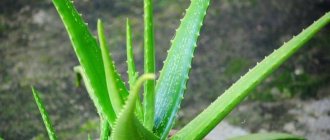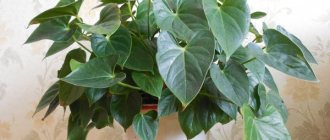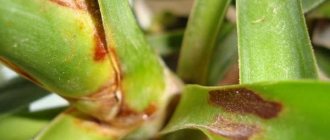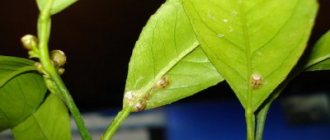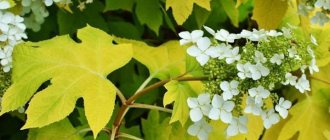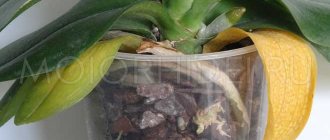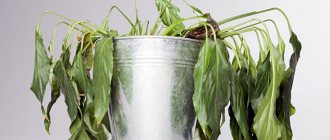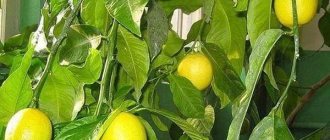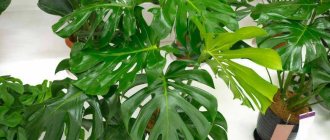Hamedorea (bamboo palm) is a plant with feathery leaves, develops slowly, and is unpretentious in care. Grows up to 80-100 cm.
Native to tropical rainforests of Central America. Therefore, it loves moist soil and air. Grows well in partial shade.
Hamedorea is difficult to tolerate dry air, especially in winter during the heating season. Because of this, spider mites may appear, and the leaves will turn yellow and dry out.
What to do in this case? Increase air humidity, for example, spray the plant with a spray bottle every day.
Briefly about care
- Temperature: 11-19 degrees.
- Flowering: rare, flowers yellow, red or orange
- Air humidity: 50-60%
- Lighting: bright diffused light.
- Where to put it: near the western or eastern window.
- Watering: as the soil dries.
- Soil: for palm trees.
- Feeding: from spring to September, fertilizer for palm trees.
- Replanting: necessary if the roots are sticking out of the drainage holes
- Reproduction: by dividing the bush or by seeds.
How to care after purchase
After you bring the plant into the house, it is better to quarantine it away from other flowers. This way you will protect the rest of the plants in the house if it turns out that the chamedorea had pests.
Daria Sumarokova
Florist with 8 years of experience
Ask a Question
If you are a beginner gardener, it is better to choose healthy plants for purchase. Check that the chamedorea does not have yellow leaves, dry tips or white bloom.
After two weeks, when the plant adapts to the microclimate of your apartment, it can be transplanted into new soil and pot.
Read more about transplanting and soil further in the article.
FAQ
Why does chamedorea turn yellow and dry out?
This plant is very sensitive to air humidity. If it is dry, the leaves turn yellow and dry out. To increase moisture levels, mist your chamedorea once or twice a day. If the lower leaves turn yellow, it’s okay, this is a natural process of dying off of the green mass. Dried leaves can be carefully removed with scissors. Hamedorea also turns yellow due to overwatering. Water the plant as the soil dries out. Just in case, check for rotten roots: remove the plant from the pot, cut off the black slimy roots. Then replant in new soil and a well-washed pot.
Why does chamedorea not grow?
Perhaps it's due to insufficient lighting. This palm loves diffused light; it does not develop well in full shade. But in general, chamedorea grows slowly. Therefore, if the plant looks healthy: there are no yellow or dry leaves, then there is no cause for concern.
Why do chamedorea leaf tips dry out?
It's either dry air or drafts. Try to provide the plant with the necessary humidity. To do this, spray chamedorea twice a day. You can also place a humidifier near the palm tree. And, of course, do not keep the plant in a draft, especially in the cold season.
Why do the leaves lighten?
Hamedorrhea can change color due to direct sunlight, poor watering or lack of nutrients in the soil.
Providing a nutrient medium (soil, fertilizer, fertilizing)
The soil
Hamedorea is an unpretentious palm tree. It tolerates poorly fertilized soils well and can grow for a long time in small pots without replanting. To grow a healthy palm tree, the roots need to provide a good nutrient environment. To do this, you can independently prepare the soil, consisting in equal measures of:
You can buy Palma soil. It is important that the mixture is light and well permeable to watering and air.
How and when to fertilize and feed
For the first 6 months, freshly transplanted young palm trees are not fertilized. Fertilizers are applied from April to August. Fertilizing with organic matter and fertilizers in the middle and end of the month will be optimal. It is easier to use liquid fertilizer “Palm”, according to the instructions.
During cold periods, well-rooted or long-growing (not transplanted) trees can be lightly fed with fertilizers in highly diluted proportions to maintain soil nutrition. Stimulating growth with short daylight hours during cold periods will lead to the formation of weakened shoots and make the appearance of the palm tree unattractive.
Where to put chamedorea
It is best to place the plant not on the windowsill, but somewhere near the window. The fact is that bright sunlight can burn the leaves. Due to excessive lighting, chamedorea will begin to lighten and turn yellow.
However, you should not keep the plant in complete shade, as it will develop slowly. Everything needs balance.
It is important to protect chamedorea from cold drafts. It does not tolerate sudden changes in temperature.
The appearance of chamedorea depends on proper lighting. It is also important to keep the plant away from radiators in winter. Dry air and overheating are detrimental to palm trees.
Possible difficulties in growing
When growing a plant you may encounter the following difficulties:
- the need for annual transplants;
- special requirements for moisture;
- exposure to diseases and pests;
- the need to prepare for winter, maintaining certain conditions for maintaining the plant in winter;
- the possibility of drying out leaves and other above-ground parts of the plant.
The difficulty also lies in creating and maintaining a certain climate regime.
Watering in winter and summer
Hamedorea does not like the soil to dry out; this will cause the leaves to dry out. But it also reacts poorly to excessive watering. Because of the flood, they will rot, and the leaves will gradually begin to turn yellow and die.
Daria Sumarokova
Florist with 8 years of experience
Ask a Question
To avoid making mistakes and ruining the plant, check the soil with your finger before each watering. If the soil is still wet, wait to water. Conversely, if it is barely wet, then it is worth watering.
In summer, the palm tree needs to be watered about 2-3 times a week, and in winter once a week. These are indicative figures. Still, it is better to independently check the degree of drying of the earthen coma.
Other Possible Problems
The plant needs not only to be watered, fed and replanted, but also to create certain conditions for its development.
For example, during the dormant period, pruning is required. The lower leaves of the palm tree tend to dry out periodically. The natural process of foliage renewal must be regulated using gardening tools. Yellowed, faded and dried leaves must be trimmed in a timely manner. Sections are treated with any alcohol solution.
Important ! The palm tree not only decorates the space, but also absorbs various toxins.
A strong and hardy chamedorea plant does not require complex care. If you monitor the temperature and lighting in the room, water in moderation, replant and prune in time, the flower will decorate any interior. Wide, voluminous palm leaves will not dry out under normal conditions.
Air humidity
This palm loves humidity. The ideal percentage of moisture in the air is 50%.
Due to dry air, brown spots may appear on the leaves, and the tips of the leaves will begin to dry out.
Moreover, at low humidity, spider mites can appear. Its activity is usually indicated by white and yellow dots on the leaves and cobwebs between the branches.
To provide the plant with the necessary humidity, you can use a humidifier or spray chamedorea from a spray bottle.
Daria Sumarokova
Florist with 8 years of experience
Ask a Question
I advise you to spray the plant in the evening in the summer once a week. And in winter, if you have very dry air in your apartment due to radiators - every day. Your chamedorea will thank you.
Exposure to light
The most important condition is to protect the palm tree from exposure to direct rays of the sun. It is better to place the flower in places with light shade. In order for the bush to develop evenly, the pot with it must be turned 180 °C every week or at least once every two weeks.
On a note!
The palm tree grows and develops well in rooms with artificial lighting.
How to wash leaves
Even if you spray your chamedorea frequently, dust will still accumulate on it. Therefore, sometimes she needs to have a shower with warm water: about once every 3 months, depending on the situation.
To do this, cover the soil with cling film so as not to over-moisten the soil. And then rinse the leaves with water.
It is best to carry out the procedure in the evening. The fact is that water combined with sunlight can cause leaf burn.
Step-by-step instructions for growing
Hamedorea can be grown from seeds. This method of propagating an exotic plant requires careful preparation of planting material and proper care.
Stages of growing Hamedorea:
- Pre-soaking of planting material. For Hamedorea, clean water is used. The seeds are left for 5-6 days.
- Use a grindstone to damage the top layer of planting material. This method will ensure greater penetration of moisture.
- Place the prepared grains in the seedling container (the sawn-off parts should be located at the bottom).
- Place the containers in a greenhouse to create a greenhouse effect.
- For 6-8 months, carry out regular ventilation and moistening of the soil.
Homemade seeds sprout after 1.5-2 months. You will have to wait six months for seedlings from purchased planting material. For transplantation, use sprouts whose leaves have reached a size of 4 cm.
Transfer
Repot your chamedorea as needed when roots are already protruding from the drainage holes of the pot. The best time to transplant is spring.
But if the plant’s leaves turn yellow due to too much watering, then remove it from the pot and inspect the roots. If you find rotten ones, cut them off, first removing all the soil.
When cutting off rotten roots, take 1 cm of living, healthy tissue.
Then sprinkle the sections with crushed activated carbon and let dry for about 1 hour. Afterwards you can plant the chamedorea in new soil. Wash the pot first with a disinfectant.
Root rotting
If you do not care for the plant according to the rules, do not monitor the composition of the soil in the pot and constantly over-moisten it, then the roots begin to rot. If this problem occurs, the only solution is to transplant Hamedorrhea.
The soil for growing a flower should be loose, light, and have good oxygen and water permeability to the root system. Replant the plant after cleaning the roots from rot and dirt. It is important to treat the root system and container with a solution of potassium manganese. The nutrient substrate must be replaced.
Hamedorea transplant
If, after transplantation, the leaves of the chamedorea plant dry out, and there are smells of rot and dampness in the pot, then the rules of care have been violated. Timely, rational watering and high-quality soil composition will help protect the palm tree from root rot.
Reproduction
The easiest way to propagate chamedorea is to divide the bush into several parts. To do this, you need to remove the plant from the pot and divide it along with the roots.
Next, you can plant the palm trees in different pots. On average, it takes a month for complete rooting.
It is best to propagate chamedorea in spring or summer, when the plant has enough light and is in an active growth phase.
You can also grow a palm tree from seeds when they are ripe after flowering:
- Soak them in water.
- Then plant the soil.
- Place the pot of seedlings in the greenhouse: cover with a plastic bag or cling film.
Leaf tips dry out due to water quality
Tap water is not suitable for watering indoor plants.
Water for irrigation should not contain alkali, acids or toxic compounds. Tap water can burn the root system of some plants, such as spathiphyllum, chlorophytum. It is categorically not recommended to water them with water taken from the city water supply.
For them, you can use melt water, rain water or settled water. Even purifying tap water with activated carbon tablets will not bring the desired result. When interacting with sorbents, fluorine and chlorine disappear, but the sorbent cannot remove impurities of calcium and salts. A compromise solution for watering indoor plants is distilled water.
Diseases and pests
The most common problem for plant owners is yellowing of the leaves. Let's figure out why this happens.
Three reasons for yellowing leaves in Hamedorea
Let's go from simple to complex.
Insufficient watering
The solution to the problem is very simple: water more often as the soil dries out.
Dry air
This problem usually appears in winter due to heating batteries. And in the summer, if it turns out to be unusually hot.
You can increase air humidity using a spray bottle. Spray the plant two to three times a day.
You can also place a humidifier in the room. Or place a container of water near the plant. The liquid will gradually evaporate and increase air humidity.
Overflow
Hamedorea loves moisture, but do not get carried away and overwater the plant. You can tell that a plant is suffering from flooding by looking at the soil: it will smell unpleasant.
But the surest way to make sure that the roots have been damaged is to remove the chamedorea from the pot and inspect the roots. Next, you need to wash them and cut off all the black and rotten ones.
Then let the roots dry for two hours. And then transplant the plant into new soil and pot. You can also use an old pot, but you must first wash it with a disinfectant.
Daria Sumarokova
Florist with 8 years of experience
Ask a Question
Test the soil with your finger before watering. If it is still wet, then pull yourself together and DO NOT water the plant. To check soil moisture, you need to deepen your finger 2-3 cm.
After transplanting, it won’t hurt to water the chamedorea with some fungicide, for example, phytosporin.
Web on chamedorea
Due to dry air, spider mites often appear. It can be identified by the webs on the plant and small yellow and white dots on the leaves.
To remove spider mites from Hamedorea, you need to wash the leaves with soap:
- Cover the soil with cling film.
- Wet the leaves with a warm shower.
- Lather and rinse off the foam with clean water.
- Let the chamedorea dry and place it separately from other plants.
This is usually enough to remove the tick. But to be sure, you can enhance the effect:
- When the plant dries out after a shower, treat it with an insecticide. For example, Vermitek: 1 ml of the drug per 1 liter of water.
- Spray the leaves: especially carefully the most affected areas.
- Cover the plant with a plastic bag for a day.
- Repeat the procedure after a week. Course: 3 weeks, one treatment every 7 days.
- Until your chamedorea recovers, keep it separate from other plants.
Shields
If you find small insects with shells on the chamedorea, then these are scale insects. They draw juices from the plant, causing the table and leaves to turn dark.
Scale insects can be removed using insecticidal preparations:
- Wipe the leaves with an alcohol-based solution.
- Remove the top layer of soil and replace it with a new one.
- Water the plant with Aktara. Pre-dilute the drug according to the instructions. Treatment should be carried out once every 7 days. Course: month. Before watering with insecticide, moisten the soil so as not to burn the roots of the plant. You can also spray Teppeka leaves.
- After a month, rinse the plant under a warm shower and remove all dead scale insects.
Important! There are many fakes on the insecticide market, so buy Aktara with a hologram.
White powdery coating on leaves
Sometimes white fibers may appear on the leaves - this is a mealybug. You need to wash the leaves with soap. And then treat the leaves with an insecticide: Aktara, Fitoverm or Teppeki.
We spray it once a week and then cover the chamedorea with a plastic bag for one day. The course is a month. Keep the plant separate from other flowers.
Aphid
The small insects on the trunk of the chamedorea are aphids. Wash the plant with laundry soap.
Then treat with any insecticide: Inta-vir, Aktara, Fufanon-nova. After processing, cover with a bag. It is also advisable to change the soil.
Diseases
For successful treatment, it is important to recognize the disease that affects chamedorrhea in time. This is not always easy to do.
Damage to the root system, for example, occurs below the soil surface. But, even in this case, there are certain external signs that will tell the grower about the onset of the disease.
Wilting of shoots
The problem can be recognized by the appearance of brownish spots of rot with white spores . The flower begins to fade.
What to do?
- If measures are not taken in a timely manner, the plant will die. The pot is thrown away along with it or thoroughly washed and disinfected with a solution of potassium permanganate.
- If the lesion is minor, treat twice with a solution of acarin, actellik or other special preparations.
- Maintaining temperature and proper hydration are excellent preventive measures.
Fusarium wilt of shoots
It affects individual shoots, which become faded, gradually wither and die . The disease does not affect the root system. If there is high humidity in the room, the base of the trunk begins to quickly rot and becomes covered with a red coating of spores.
What to do?
- Monitor soil moisture, room humidity and temperature conditions.
- In case of minor damage, treatment with special preparations is required: actellik or phytoferm.
- If the damage is deep, it will not be possible to save the flower. They throw him away. The container can be thoroughly rinsed, doused with boiling water and potassium permanganate.
- It is advisable to carry out work wearing silicone gloves using special tools. After use, they are thrown away or disinfected.
Anthracnose
The leaves are covered with small light spots, which over time change color to brown, the edges become convex with a yellowish border. The spots are located chaotically, merging when the lesion is deep.
What to do?
- Indoors, it is recommended to reduce air humidity, stop spraying leaves, and strictly adhere to the watering regime.
- The palm tree is treated with Rovral.
- Deep damage leads to death. The flower is thrown away and the container is disinfected.
Varieties of Hamedorea
Several types of Hamedorea are grown indoors.
Hamedorrhea Ernest-Augustus
Height more than 1 meter, flowers red. The leaves look a bit like a fish tail. Forms aerial roots.
Hamedorea graceful (elegans)
Height more than 1.5 meters. Flowers with an orange tint.
Hamedorea Metallica
Height up to 50 cm.
Hamedorea elegans variegata
Chamedorea variegata has white leaves. Like other variegated plants, it requires more light than its green relatives.
Features of culture
There are about 130 species in the genus of woody flowering plants - Chamaedorea, and only a small part is cultivated as decorative foliage plants.
In nature, the low-growing palm tree grows in tropical rainforests, in the foothills under the crowns of tall trees; at home, it will grow from 1.5 to 2 m in height, with a crown diameter of 60-70 cm. There are dwarf varieties, the height of which does not exceed half a meter. In appearance, it can be a bush with several erect stems, a tree with a thin trunk, or less often a liana. In several varieties, aerial roots grow in the lower part of the trunk with age.
The word "chamaedorea" consists of the words "chamai" + "dorea", which means "low (dwarf)" + "gift". Due to the similarity of the stems to bamboo shoots, Hamedorea is sometimes called the bamboo palm.
The leaves are long (about 60 cm), or entire, or consist of narrow (2.5-3 cm) alternate segments 10-15 cm long. The surface of the leaf blade is glossy, with clearly visible longitudinal veins; in some varieties the upper part is forked.
The plant is dioecious, many male flowers are produced, they are small, bright yellow, red, collected in an inflorescence similar to a spike or panicle. The female flower is single on a peduncle and can be red, yellow, or orange. After flowering, a fruit-berry is formed. It begins to bloom at 3-4 years of age; the flowering period is not tied to the season.
Varieties of chamedorea: Ch. Ernesti-Augusti, Ch. elegans, Ch. concolor, Ch. elatior, Ch. metallica ).
Ch. Ernesti-Augusti
Ch. elegans
Ch. metallica
